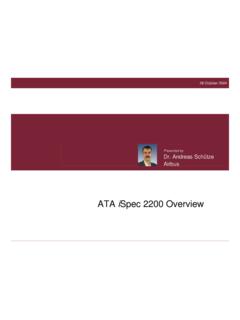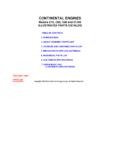Transcription of Aircraft Reliability Data Collection and Exchange ...
1 Aircraft ReliabilityAircraft ReliabilityData Collection and ExchangeData Collection and Exchange -- spec2000 chapter 11 spec2000 chapter 11--E-Business ForumAtlanta. 29 Oct. 2004 Geoff ChickGeoff ChickAir CanadaAir Canada22 spec2000 chapter 11 spec2000 chapter 11 What is it ?What is it ? A common language that allows aviation industry partners to Exchange detailed Reliability data easily and cost effectively. It IS already published in the Spring 2004 release of the ATA spec2000 E-Business standards. (If your organization subscribes to spec2000 for standards such as material procurement, you already have access to the Reliability data records in chapter 11).
2 spec2000 chapter 11 spec2000 chapter 11 What is it NOT ?What is it NOT ? It is NOT a database or central repository for Reliability data . It is NOT a Reliability report generation chapter 11 spec2000 chapter 11 --ScopeScope ReliabilityAnalysis& ReportsAirframe OEMD atabaseOperator/OEMR eliability DataExchange andCollectionOut of ScopeIn Scope44 The need for Reliability data standards:The need for Reliability data standards:lOperators need to collect, organize and report Reliability data to many different organizations : Manufacturers, suppliers, regulatory authorities, each other. lSome of the benefits of Reliability data Exchange :nAssist operators and manufacturers to attain and maintain higherreliability through trend maintenance program development, escalation and de-escalation.
3 NDetermine which modification has a better payback by comparing removal and failure rates of operators incorporating various Service if certain problem areas are unique to an operator or if others are experiencing the same Reliability data flow, where we are Reliability data flow, where we are 1 AIRLINE 2 AIRLINE 3 SUPPLIER 1 SUPPLIER 2 SUPPLIER 3 AIRFRAME MANUFACTURER66 Current Reliability data flowCurrent Reliability data flow The volume of data Exchange is high and the industry is currently using multiple data Exchange languages. This adds complexities, inaccuracies and costs to the Exchange processes, resulting in data and data analysis that is less effective and less chapter 11, simplified Exchange , where we need to beSpec2000 chapter 11, simplified Exchange , where we need to beMultiple data sources, one standard for sharing dataScheduleInterruptionsPilot SnagsHeavy MtceFindingsAirline ComponentShop FindingsAirline sReliability Department3rdParty MtceProvidersTrading Partners:Airframe ManufacturersSuppliersEngine ManufacturersMaintenance ProvidersOther Operators.
4 For Technical PerformanceData ExchangeSPEC2000 chapter 11 ONE STANDARD FORMAT FOR CONTENT AND Exchange METHODOLOGY 88 spec2000 chapter 11, Overview & Evolution spec2000 chapter 11, Overview & Evolution lSPEC2000 chapter 11 has been created by the aviation industry. lThe ARDTF membership is the largest active spec2000 task force. A smallsamplingof task force representatives : All Nippon Airlines, Virgin, SAS, Iberia, Continental, Delta, United, Westjet, American, Fedex, Air Canada, Boeing, Airbus, Bombardier, Embraer, Dassault-Falconjet, Parker, Hamilton Sundstrand, Thales, Smiths, Teijin Seikki, Honeywell, Pratt and Whitney, IAE, NBAA, ERA, Lufthansa Technik, SR Technics.
5 To name but a evolution of spec2000 chapter 11 Component ReliabilityData Collection Task ForcebeginsCreated Component Reliability data Collection standard inChapter 11 Aircraft ReliabilityData Collection Standardization beginsARDTF establishes framework for developingaircraft Reliability data standardsSpec2000 chapter 11 Conditional Acceptanceof Aircraft Reliability standardATA releasesSpec2000 chapter 11 NOWtime to Become spec2000 Compliant!04/199702/200109/200101/200209 /200305/2004 The Aircraft Reliability data Task Force is the largest spec2000 Task Force ever!1010 spec2000 chapter 11 Reliability data RecordsSPEC2000 chapter 11 Reliability data Records1111 spec2000 chapter 11 recordsSPEC2000 chapter 11 recordsChapter 11 has 9 records : lLRU Removal recordnPurpose : Collect details of the components removed from an Aircraft as well as reasons for removal and details of component being include elements such as the manufacturer part and serialnumbers, the operator s unique part and serial numbers if applicable, hours and cycles data for the removed and installed Findings recordnPurpose.
6 Collect detailed component tear down reports from an airline s shop or other repair include elements such as fault found, part numbers of thepiece parts that are replaced, modifications incorporated in theshop chapter 11 recordsSPEC2000 chapter 11 recordsChapter 11 records (ctd.) lAircraft Hours and Landings recordnPurpose: Collect detailed hours, cycles and utilization data from operators. This data can also be used as the basis for MTBUR calculations, include elements such as days out of service counts, ETOPS specific hours and cycles, Event recordnPurpose : To capture Aircraft event data such as delays, cancellations, incidents, are very comprehensive and can capture all elements of a schedule interruption tracking system.
7 Attributes specific to ETOPS operations are also captured with specific data chapter 11 recordsSPEC2000 chapter 11 recordsChapter 11 records (ctd.)lAircraft Logbook recordnPurpose : Collect technical/journey log entries such as pilot reports, maintenance corrective action, include elements such as discrepancy symptom code, corrective action codes, findings code. lScheduled Maintenance recordnPurpose : Collect scheduled (heavy and line) maintenance data , findings and corrective action, and provide reference ability back to the operator s maintenance include elements such as OEM MPD task number, operator unique task number if applicable, task inspection method and associated chapter 11 recordsSPEC2000 chapter 11 recordsChapter 11 records (ctd.)
8 LService Bulletin/Modification recordnPurpose : Provide data on service bulletin/mod incorporation and Status Change recordnPurpose : Capture changes in Aircraft ownership, operator, long term storage disposition, engine model changes, Counts recordnPurpose : Collect summarized rate and count information on an operator's fleet, schedule interruption counts by ATA, chapter 11 records spec2000 chapter 11 records EVENT RECORD: Field # Type Max Length Attribute Name Example CONDITION SPEC 2000 TEI Comment 8 AN 6 Aircraft Model 757 MANDATORY AMC 9 AN 6 Aircraft Manufacturer Serial Number 25398 MANDATORY AIN 10 AN 10 Aircraft Registration Number N550UA CONDITIONAL REG 11 AN 6 Operator Aircraft Internal Identifier 550 CONDITIONAL OIN 12 AN 5 Aircraft Engine Manufacturer Code 74455 CONDITIONAL MFR CAGE code or NSCM code 14 AN 20 Originating Discrepancy Identifier Log Page # MANDATORY OEI In Chap 11 this is identified in removals as Operator Event Identifier 15 AN 20
9 Maintenance Action originating Identifier (the link to the original discrepancy) TBD CONDITIONAL Internal A/L ref # to link MA together 16 AN 20 Originating Incident Reference Number TBD MANDATORY Uniquely identifies the original incident 17 AN 2 Interruption Code P= Primary C = Consequential MANDATORY Primary, Secondary/ Continuation/ Subsequent 18 AN 2 Total Number of Consequential Interruptions 3 CONDITIONAL If the Interruption Code = P 19 AN 13 Discrepancy (Symptom) ATA System Code 215100 MANDATORY CSN In CSDD shown as Catalog Sequence Number Field DefinitionsField Name & FormatORIGINATING INCIDENT REFERENCE NUMBERIDENTIFIES THE ORIGINATING DOCUMENT REFERENCEDFOR INFORMATION WHEN RECORDING A SPECIFIC AIRPLANE Type (Mandatory vs Conditional)1616 spec2000 chapter 11 Reliability data RecordsSPEC2000 chapter 11 Reliability data Records Records have been structured to include a field that can be usedto link records together.
10 This allows more efficient drill down and analysis to find rootcause chapter 11 RecordsSpec2000 chapter 11 #2 comm will not receiveDCT#2 VHF: TX-CARRIER ONLY RX-STATIC-UNREADABLE. NO VOICE AT TRANSCEIVER - STATIC-RT TRANSCEIVER - STATIC-RT & REPLACED VHF TRANSCEIVER. CONDUCTED TEST IAW TASK 23-11-00-710-801. TEST "Power supply failure: Unrelated. Replaced. Intermittent. MX19 OUT - 3522;911M26 - Fault code present: Unrelated. Intermittent. DPU FC 11101;999 - Unit sent to XXX; CONFIRMED DEFECT. DPU BOARD the Event, Logbook, LRU Removal, Shop Report1818 spec2000 chapter 11 Reliability data RecordsSPEC2000 chapter 11 Reliability data RecordsExchange ProtocolExchange ProtocollBeing cognizant of the evolution of data Exchange formats, a decision was made by the ARDTF to adopt XML, including the development of XML schemas for the chapter 11 records that are already chapter 11, Value Proposition spec2000 chapter 11, Value Proposition Airlines can achieve improved Aircraft Reliability and cost savings a result of enhanced Reliability data : quality; quantity; depth; and exchang











